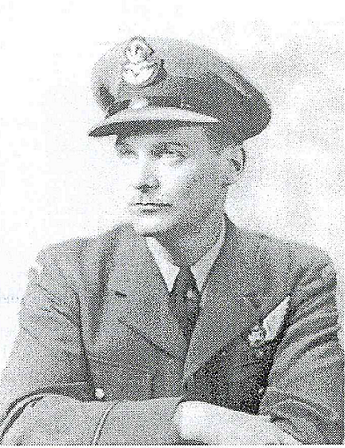JACK GOLDSTEIN
By Eddy Kaplansky

Jack Goldstein in the Royal Canadian Air Force
Jack Goldstein joined the Royal Canadian Air Force in 1942 and after completing communication and air gunnery courses, received his WO/AG (wireless operator/air gunner) wing. Following specialized operational training in England, he was assigned to an RCAF heavy bomber squadron. In the ensuing months he flew 41 night bombing raids against Germany in Avro Lancaster bombers, more than enough to earn him a gold RAF “Ops” wing.
He was among the very early Canadian Machalniks and probably the first in the budding Israel Air Force, having signed up in March 1948. Jack’s IAF career began in Perugia, Italy, where he spent most of April helping prepare a C-46 cargo aircraft for its ferry flight to Israel. The C-46 had been there since early March. It finally left Perugia on 3rd May, piloted by Arnie Ilowite and Harry Schwartz, both from the U.S.A., with Jack as radio operator. The C-46 had been under surveillance by Italian authorities and the FBI, when it left Perugia on 3rd May, on the pretext of a test flight to Catania, Sicily, supposedly to return the next day. They left Catania on 4th May, cleared for Perugia, but changed course for Israel soon after take-off.
They reached Israel in the dark hours of 5th May unannounced, as the radio wasn’t working, and found the Ekron field blacked out. When runway lights finally came on, the crew, all strangers to the country, had no way of knowing if it was Ekron or an Arab-held field. In any case, Ilowite landed anyhow, as they were low on fuel. But after landing he kept the engines running, ready for take-off, while Jack cautiously opened the cabin door with gun in hand, until he was sure they were safe. It was the first ATC (Air Transport Command) aircraft to arrive in Israel.
In the following days Ilowite and Jack flew the C-46 as a two-man crew, making repeated low-level drops of food and supplies to besieged Yechiam. Their luck held until 11th May, when a burst of machine gun fire shattered some flight instruments as they neared Yechiam at tree-top height for another drop. The cockpit was showered with glass fragments and alcohol droplets which cut their faces and blinded Ilowite briefly. Jack took over from the co-pilot seat and kept the plane flying safely until Ilowite opened his eyes again a minute or so later.
The next two months saw Jack on the C-46s flying the “Operation Balak” airlift from Czechoslovakia to Israel. On 15th July he was radio operator on one of the three B-17s that bombed different Egyptian targets while being ferried to Israel from Zatec, Czechoslovakia. Documents on file at the IDF Archives show that Jack’s was the B-17 that bombed Cairo. In later years he rarely spoke about having participated in that historic raid.
Jack was a founding member of 69 Squadron, which was created especially for the B-17s even before their arrival. He and the B-17s took part in every remaining campaign of the War of Independence. Jack stayed on in Israel after the war and co-founded a communications equipment company. After this company merged with another new company to form Tadiran Ltd., Jack returned to Montreal.
Always of cheerful disposition and a cool cat under fire, flier friends dubbed him “Smiling Jack” after the 1940s comic book aviator of that name. It was Jack who suggested the name “The First Fliers” for my paper on the IAF early aircrew personnel, for which I am grateful.
Source: American Veterans of Israel Newsletter: Winter 2002

